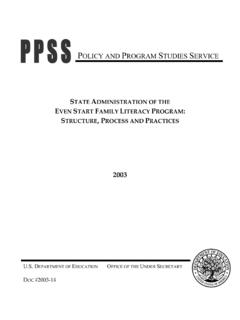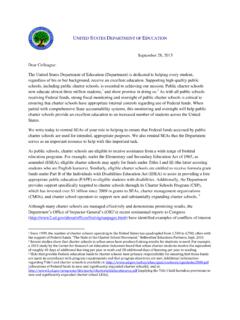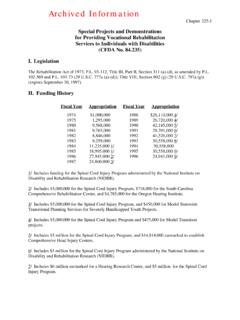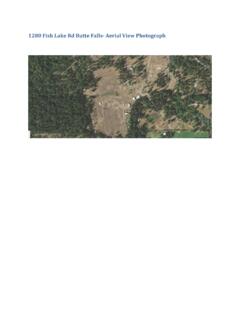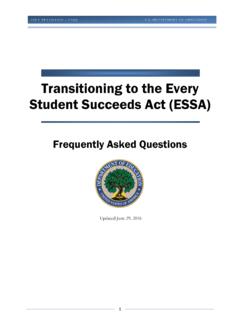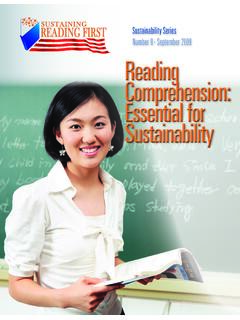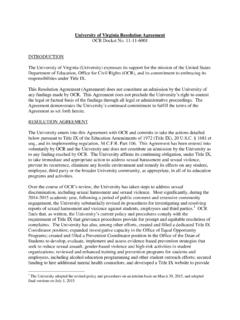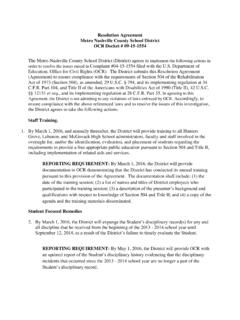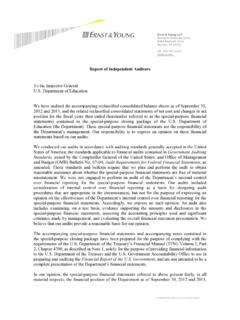Transcription of Talk, Read and Sing Together Every Day! - ed
1 Talk, Read and Sing Together Every Day!Tips For Infant & Toddler Teachers and CaregiversA language-rich environment is one in which babies and toddlers are surrounded by talking, singing, and reading and have many opportunities throughout their day, across all activities, to communicate with others and engage in back-and-forth interactions. A language-rich environment is important to children s early brain development, and can have strong effects on early language, vocabulary, reading, and math skills, as well as on children s social-emotional development. Although many babies and toddlers do not have many words to talk back, they communicate using their own baby language.
2 Baby language can be gestures, babbling, coos, smiles, and looks. Caregivers can have back-and-forth interactions with babies by talking to them and responding to their baby language . Research shows that some young children are exposed to more language in their homes, early learning programs, and school settings, than other children. This difference in the number of words and back-and-forth interactions children are exposed to during the early years is called the word gap . Below are some tips that infant/toddler teachers and caregivers can use to help bridge the word gap by enriching the language environment of all babies and toddlers in their care, including babies or toddlers who do not speak yet, those with disabilities or delays, and those who are learning more than one with families and encourage them to try these strategies at home, in their home language.
3 For children with disabilities or delays, communicate with their other service providers and keep each other informed about the strategies you are using to enhance their language with babies and toddlers is a brain building activity! Every time you talk to a baby and have a high-quality back-and-forth interaction, new connections in that baby s brain are made. The more you engage with babies and toddlers in this way, the more they learn to understand and use new words and concepts. Below are some tips for talking with babies and toddlers and engaging in high-quality back-and-forth interactions.
4 Move to the child s level and make eye contact. Mirror the child s tone. For example, if the child is smiling and happy, use a happy, upbeat tone of voice. Use Parent-ese! Parent-ese is a type of adult speech where an adult talks to a child in an exaggerated, animated, and repetitive way. Babies and toddlers get excited when they are spoken to in fun and interesting ways. Parent-ese captures babies attention and can help them learn. Comment! Comment about everything in the baby s environment, such as their actions and other people s actions, objects, toys, foods, activities, and daily events.
5 Narrate your routines! Label! Babies and toddlers are learning to match words with different things in their world. Labeling at Every opportunity helps babies and toddlers learn new words and understand their meaning. Point and look at objects when describing them for babies/toddlers. Make sure the baby/toddler looks at who or what you are pointing to. TALK TALK TALK! Model! Model the correct use of words, the use of familiar words in new situations and in longer sentences, and the use of new words. The more that teachers model language for babies and toddlers, the more children learn. Ask questions!
6 Ask different types of questions, including open-ended questions. Give them enough time to respond. Giving toddlers choices may help them respond. For example: Did you use a marker or a crayon to draw your picture? Follow the child s lead and talk about it! Identify what the child is looking at, playing with, holding, doing, or interested in. Label and describe whatever it is they are engaged with. Jump in and play with them, narrating what you are doing Together . Have conversations! Some babies and toddlers may not have words yet, but they still communicate in their own baby language.
7 This is usually in the form of babbles, coos, laughter, smiles, looks, and gestures. Talk to them and reply to their baby language . That is called a back-and-forth conversation - baby style! Use many different words! Introduce new or uncommon words, explain what they mean, and repeat them across different activities throughout the day. For example, use words like huge, humongous, or enormous to describe things that are very big. Repeat and Expand! Repeat the words babies/toddlers use back to them and expand by adding a little more. For example, if the child says airplane! , you can say yes, the airplane is flying in the sky!
8 For children learning more than one language, use even more gestures and body language. Reading to babies and toddlers helps build their language and early literacy skills and helps them get ready for school. For infants and toddlers, the most important part of reading is interacting while you re reading. That means talking about the pictures in the book, asking questions, making fun comments, and connecting the story to the child s life. It s not as important to read Every word in the book at this age. Instead, it is about learning new words and concepts while having fun! Introduce children to books!
9 Demonstrate the appropriate way to hold a book. Point out the parts of the book, such as the front cover, the title, and the author s name. Label the objects in the book and connect them to real life! Identify and define new words and encourage babies/toddlers that are beginning to speak to repeat these words. Make connections between the book, new words, and the baby/toddler s life. For example, if you read a story about a teddy bear, ask the child about his or her teddy bear at home. Repetition helps! Babies and toddlers learn more when the same story is repeated to them multiple times. Point out different parts of the story, new objects or new characters.
10 Introduce new words, and ask new questions with each it an interactive experience! Ask lots of questions and make comments on things the child points to or talks about. Play fill in the blank where the child fills in words of a familiar story. For example, in reading The Three little Pigs you might say I ll huff and I ll puff and I and wait for the child to fill in the blank. Books where the child can touch different textures, open flaps, push buttons, and make sounds allow children more opportunities to interact. READ READ READ!Follow the child s lead! Let the child pick the book or pick a book that you think may interest the child.
